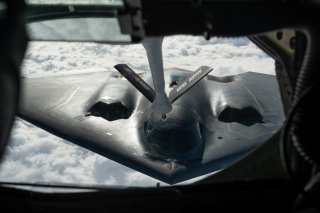Can China's H-20 Stealth Bomber Strike the United States Undetected?
The new H-20 bomber reportedly has a range of up to 7,500 miles, making it possible for a single sortie from mainland China to reach targets over the United States without needing to refuel.
China’s emerging “B-2 copycat” H-20 stealth bomber is expected to introduce an entirely new array of threat dynamics to the United States, as it further cements China’s nuclear triad and massively extends its nuclear attack range to include major portions of the continental United States.
The new H-20 bomber reportedly has a range of up to 7,500 miles, making it possible for a single sortie from mainland China to reach targets over the United States without needing to refuel. This is a substantial development, as refuelers can help reveal the position or presence of a stealth bomber. The H-20’s long range raises the possibility that it will be capable of undertaking undetected nuclear attack missions against major U.S. targets.
According to the South China Morning Post, which cited a report by the London-based Royal United Services Institute for Defence and Security Studies, “the state-of-the-art H-20 can carry a massive weapons payload of 45 tonnes and fly great distances without mid-air refueling.”
While the exact composition of its stealth properties or radar-signature-reducin technologies may not be fully known, available photos and renderings reveal an aircraft which are nearly indistinguishable from a U.S. B-2 Spirit stealth bomber. There is nothing particularly surprising about this, given China’s well-known and well-documented habit of stealing or copying U.S. weapons designs. This certainly seems apparent in the case of the H-20, which features a similarly rounded upper fuselage, blended wing body, curved upper air inlets and essentially no vertical structures.
The B-2 is known for its long-endurance flights as well; during Operation Enduring Freedom in the opening days of the war in Afghanistan, U.S. B-2s flew forty-four-hour missions from Whiteman Air Force Base, Mississippi, to Diego Garcia, a small island off of the Indian coastline. From there, B-2s flew bombing missions over Afghanistan in support of U.S. ground forces. While this mission likely required refueling, it does speak to the merits and tactical advantages of long-endurance bombing.
It is also not clear if the H-20 could succeed in rivaling a U.S. B-2 given the extent of upgrades and adaptations the Air Force has provided to the 1980s platform. The B-2 will soon have air-defense evading Defensive Management Systems sensors, a thousand-fold faster computer processor, and weapons upgrades to include an ability to drop the B-61 Mod12 nuclear bomb. The B-2, which is expected to fly alongside the new, state-of-the-art B-21 Raider stealth bomber until sufficient numbers of B-21s arrive, will be a much different plane in a few years when compared to its 1980s origins, as the Pentagon hopes to ensure the platform remains relevant and powerful for many years into the future.
Kris Osborn is the defense editor for the National Interest. Osborn previously served at the Pentagon as a Highly Qualified Expert with the Office of the Assistant Secretary of the Army—Acquisition, Logistics & Technology. Osborn has also worked as an anchor and on-air military specialist at national TV networks. He has appeared as a guest military expert on Fox News, MSNBC, The Military Channel, and The History Channel. He also has a Master’s Degree in Comparative Literature from Columbia University.
Image: DVIDS.

